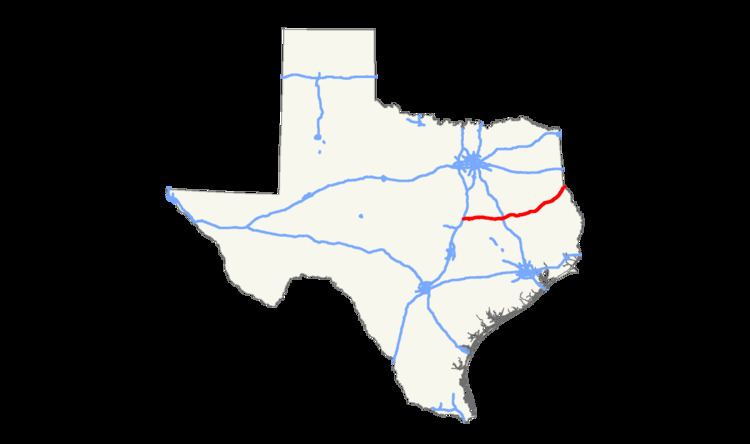Existed: 1939 – present Length 342.3 km | SH 139 SH 140 → Constructed 1939 | |
 | ||
West end: I-35 in Bruceville-Eddy East end: I-69 / US 84 in Joaquin | ||
State Highway 7 is an east–west state highway that runs from Interstate 35 south of Waco to U.S. Highway 84 about 3 miles (5 km) west of the Texas-Louisiana state line. Between Crockett and Nacogdoches, SH 7 passes through the Davy Crockett National Forest.
Contents
Map of TX-7, Texas, USA
History
SH 7 was one of the original 26 state highways proposed in 1917, proposed as a 'Central Texas Highway.' In 1919 the routing was mostly proposed between San Angelo and Goldthwaite, but only the segment to Paint Rock was created. From Goldthwaite, the road parallels U.S. Highway 84 to Waco. The remainder follows SH 164 to Buffalo, was unbuilt between Buffalo and Jasper, and U.S. Highway 190 to the State Line.
Possibly due to the amount of construction necessary to build this route as proposed, by 1919 the road was completely rerouted via the current U.S. Highway 84 through Lubbock to Sweetwater. Between Sweetwater and Coleman, the road was not constructed as proposed. SH 7 returns to US 84, through Waco to Palestine, heads south on U.S. Highway 287 to Crockett, turns to Lufkin via the current SH 7 then SH 103 and finally onto Jasper and Newton via present day U.S. Highway 69, SH 63 and US 190.
In 1926, U.S. Highway 70, 80, and 67 were overlaid over pieces of SH 7. While the entirety of the SH 7 maintained its number, the road had been realigned yet again, mainly due to constructions issues. The Sweetwater-Coleman road was never built, and SH 7 was rerouted over existing roads into Abilene. The road's east terminus was shortened to Long Lake. By 1933, the highway was extended east across SH 294 into Alto, SH 21 to Nacogdoches, ending in Joaquin via current SH 7, replacing SH 76.
By 1939 most of the highway had been overrun by a patchwork of US Highways, leaving only a small portion from Joaquin to Crockett remaining, rerouted yet again to a more southerly route from Nacogdoches. In 1940, SH 7 extended west to Centerville. Later that year, the section from Ratcliff to Crockett was cancelled. A few days later, SH 7 extended west to Marquez. In 1942, the section from Ratcliff to Crockett was redesignated as part of SH 7. SH 7 replaced SH 139 from Chilton to Marquez (originally ended in Marlin; extended east in 1943) in 1948, reaching its current routing by 1990, replacing a portion of FM 107.
SH 7A was a spur route of SH 7 that split off at Coleman and traveled southwest through San Angelo to Fort Stockton. It was transferred to portions of SH 23, SH 30 (now US 277), and SH 99 (later SH 10) by 1933.
SH 7B was a spur route of SH 7 that split off at Lufkin and traveled southwest through Groveton to Trinity. By 1933 it had been renumbered SH 94.
Route description
SH 7 begins at an intersection with Interstate 35 and FM 107 in extreme southern McLennan County in Central Texas. The highway travels east until it reaches an intersection with US Route 77. It briefly travels south with US 77 around the western side of Chilton before turn east again through town. The highway continues east through sparsely populated farmland before reaching Interstate 45 at Centerville. The highway continues east, passing through Crockett before turning northeast and passing through the center of the city of Nacogdoches. The highway continues to its final location, ending at US 84 in extreme northeast Shelby County, just short of the Louisiana State Line.
